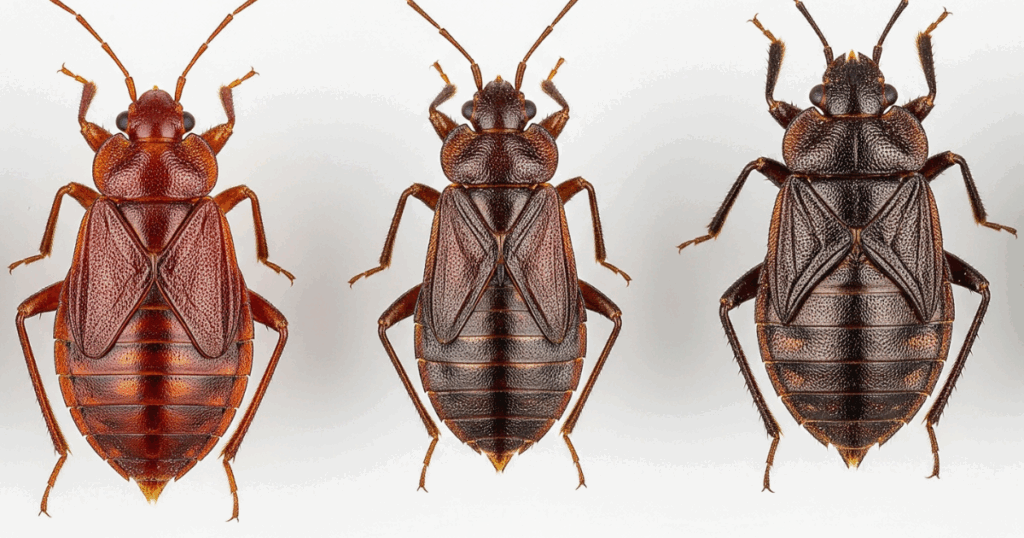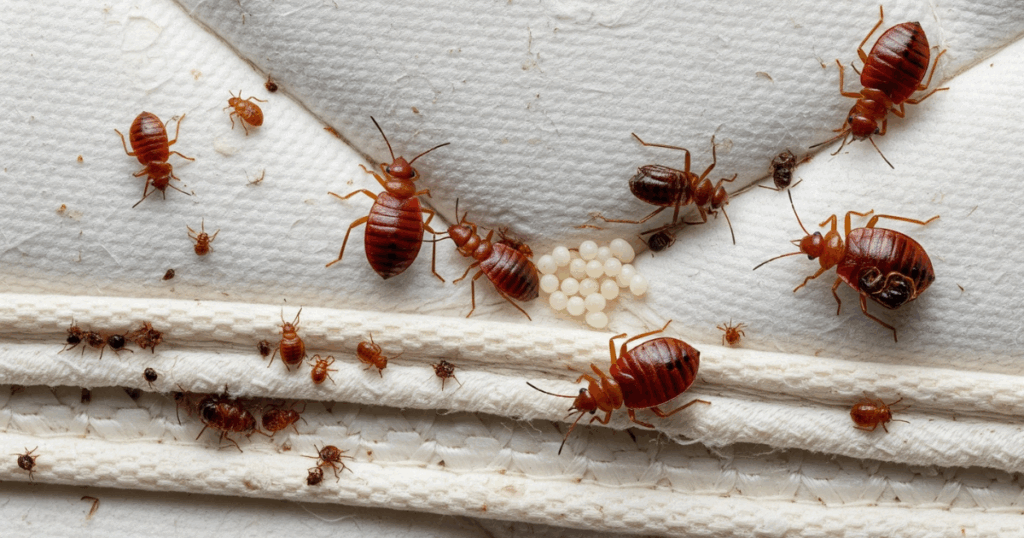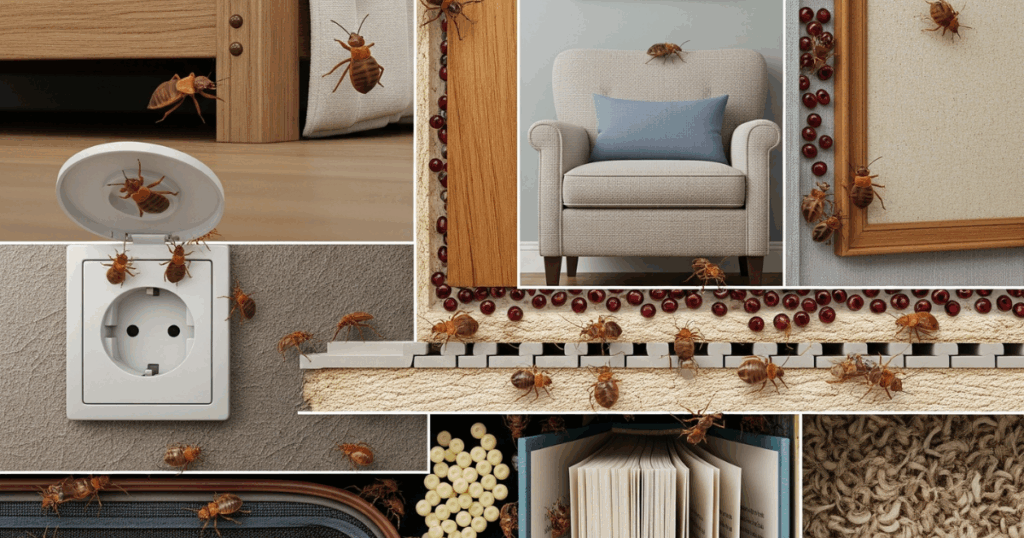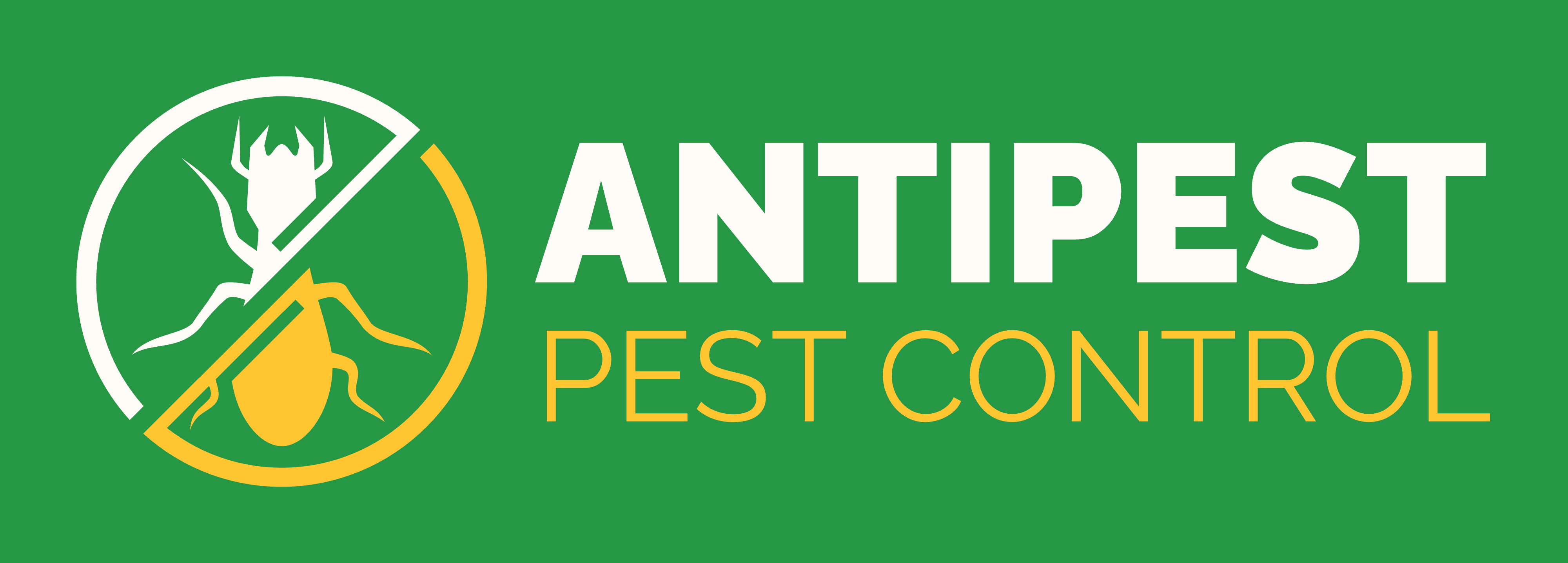10 Shocking Spots Where Bed Bugs Hide 1. Mattresses and Box Springs, 2. Bed Frames and Headboards, 3. Upholstered Furniture, 4. Wall Hangings and Photo Frames, 5. Baseboards and Molding, 6. Electrical Outlets and Appliances 7. Luggage and Personal Items, 8. Books and Paper Items, 9. Curtains and Textiles 10. Carpets and Rugs
Bed bugs are among the most persistent household pests, and understanding where bed bugs hide is crucial for effective detection and elimination. By learning exactly where bed bugs hide, you can interrupt their nightly blood meals and stop an infestation before it explodes. Because their flat bodies let them disappear into almost any crack, discovering where bed bugs hide often feels like a scavenger hunt gone wrong. Yet once you know the common, and surprising, spots where bed bugs hide, you gain the upper hand against these elusive insects. This comprehensive guide will explore everything you need to know about bed bugs, from their hiding places to complete removal strategies.
Table of Contents
What Are Bed Bugs?
Bed bugs are small, parasitic insects from the genus Cimex that feed exclusively on blood, usually at night. The most common species affecting humans is Cimex lectularius, known as the common bed bug. These reddish-brown insects are about 3/16-inch long with oval, flattened bodies that resemble apple seeds in color but are closer to a lentil in size.
Where bed bugs hide depends largely on their nocturnal feeding habits. During the day, bed bugs retreat to dark, hidden locations where they remain undisturbed. Their flat bodies allow them to squeeze into incredibly narrow spaces, making detection challenging for homeowners.
| Bed Bug Characteristics | Details |
| Size | 3/16-inch long (4-5mm) |
| Color | Reddish-brown to mahogany |
| Shape | Oval, flattened body |
| Lifespan | 4-6 months on average |
| Feeding frequency | Every 5-10 days |
| Survival without feeding | Up to 1 year |
Adult bed bugs can survive for months without feeding, which enables them to remain hidden until conditions are favorable for emergence. This remarkable survival ability is why understanding where bed bugs hide is so critical for successful identification and treatment.
Types of Bed Bugs

Understanding the different types of bed bugs helps in proper identification and treatment. There are approximately 90 species of bed bugs worldwide, but only three species feed on humans:
| Bed Bug Species | Scientific Name | Geographic Distribution | Characteristics |
| Common Bed Bug | Cimex lectularius | Worldwide, temperate climates | Most widespread, adapts to human environments |
| Tropical Bed Bug | Cimex hemipterus | Florida, Africa, Asia, South America | Prefers warm, humid climates |
| West African Bed Bug | Leptocimex boueti | West Africa, South America | Primarily feeds on bats, occasionally humans |
Common Bed Bug (Cimex lectularius)
The most widespread species found globally, particularly in temperate climates. This type adapts well to human environments and is the primary concern for most homeowners wondering where bed bugs hide.
Tropical Bed Bug (Cimex hemipterus)
Primarily found in tropical regions such as Florida, Africa, Asia, and South America. This species has similar characteristics to the common bed bug but prefers warmer climates.
West African Bed Bug (Leptocimex boueti)
Found mainly in West Africa and South America, this species primarily feeds on bats but will bite humans when convenient. Unless you live in these regions or have recently traveled there, this type is unlikely to infest your home.
Signs of Bed Bug Infestation

Recognizing bed bug signs helps identify infestations before they spread to new areas. Look for these indicators in all locations where bed bugs hide:
- Dark stains or spots – Bed bug excrement appears as dark specks along mattress seams and hiding places
- Rusty or reddish stains – Crushed bed bugs leave blood stains on sheets and surfaces
- Sweet musty odor – Large infestations produce a distinctive smell
- Skin castings – Pale yellow molted skins found near hiding places
- Live bugs – Adult bed bugs visible during daylight hours indicate severe infestations
10 Shocking Spots Where Bed Bugs Hide

Knowing exactly where bed bugs hide is essential for thorough inspection and treatment. Here are the top 10 hiding places these persistent pests prefer:
1. Mattresses and Box Springs
The most common locations where bed bugs hide include mattress seams, tags, and under labels. Box springs provide numerous crevices and hiding spots, making them prime real estate for bed bug colonies.
2. Bed Frames and Headboards
Bed bugs frequently hide in joints where two pieces of wood meet, as well as any cracks or crevices in bed frames. Headboards attached to walls provide excellent hiding spots behind the mounting hardware.
3. Upholstered Furniture
Couches and chairs offer ideal hiding places in seams, between cushions, and in furniture joints. Where bed bugs hide in furniture often mirrors their mattress preferences, seeking out dark, undisturbed spaces.
4. Wall Hangings and Photo Frames
The space behind wall hangings and photo frames serves as perfect hiding spots. Bed bugs can easily crawl into narrow gaps between frames and walls, remaining completely out of sight.
5. Baseboards and Molding
Loose baseboards provide excellent hiding places, especially at the junction where walls meet the ceiling. These areas often go unchecked during routine cleaning, making them ideal for where bed bugs hide.
6. Electrical Outlets and Appliances
Bed bugs are attracted to warmth, making electrical outlets and appliances common hiding spots. The heat generated by electronics creates an attractive environment for these pests.
7. Luggage and Personal Items
Suitcases, purses, and personal belongings frequently harbor bed bugs, especially after travel. This is often how infestations begin, as bed bugs hitchhike from infested locations.
8. Books and Paper Items
Books, magazines, and paper clutter provide numerous hiding spots. The spaces between pages and book bindings offer perfect concealment for bed bugs seeking shelter.
9. Curtains and Textiles
Fabric folds in curtains, linens, and clothing create ideal environments where bed bugs hide. These locations provide both concealment and easy access to sleeping hosts.
10. Carpets and Rugs
Edge areas of carpets, especially where they meet walls, offer hiding places for bed bugs. The fibers and padding beneath carpets can harbor significant populations if infestations are severe.
| Hiding Location | Why They Choose It | Detection Tips | Treatment Priority |
| Mattresses & Box Springs | Close to sleeping hosts, dark seams | Check seams, tags, labels with flashlight | High |
| Bed Frames & Headboards | Wood joints and crevices | Inspect where wood pieces meet | High |
| Upholstered Furniture | Fabric seams and cushion gaps | Check between cushions, furniture joints | High |
| Wall Hangings & Frames | Dark spaces behind frames | Look behind pictures and mirrors | Medium |
| Baseboards & Molding | Loose edges and wall junctions | Check with flashlight along walls | Medium |
| Electrical Outlets | Warmth from electrical current | Remove outlet covers for inspection | Medium |
| Luggage & Personal Items | Travel from infested locations | Inspect after every trip | High |
| Books & Paper Items | Spaces between pages | Check book bindings and paper stacks | Low |
| Curtains & Textiles | Fabric folds provide concealment | Examine curtain pleats and hems | Medium |
| Carpets & Rugs | Edge areas and padding beneath | Check carpet edges near walls | Low |
“Want a cleaner, bug-free space? Discover expert tips on how to get rid of gnats fast.”
Advanced Bed Bug Hiding Places
As infestations grow larger, bed bugs expand their territory to more unusual locations. Where bed bugs hide in severe infestations includes wall cavities behind peeling wallpaper, inside electrical components, wooden furniture joints like dresser drawers and cabinet seams, and even inside electronics that generate warmth.
- Wall cavities and loose wallpaper – Behind peeling wallpaper and inside wall voids
- Light switches and fixtures – Inside electrical components and switch plates
- Wooden furniture joints – Dresser drawers, cabinet seams, and screw holes
- Electronics and appliances – Inside televisions, computers, and other warm devices
- Stuffed toys and soft items – Children’s toys and decorative pillows
| Unusual Hiding Spots | Infestation Level | Why They’re Chosen |
| Wall cavities & loose wallpaper | Severe | Protection and breeding space |
| Light switches & fixtures | Moderate to Severe | Warmth from electrical components |
| Wooden furniture joints | Moderate | Dark crevices in dresser drawers |
| Electronics & appliances | Moderate | Heat generation attracts bugs |
| Stuffed toys & soft items | Any level | Easy concealment in fabric |
Comprehensive Bed Bug Removal Strategies
Effective bed bug removal requires a multi-pronged approach targeting all locations where bed bugs hide. The process typically takes weeks to months, depending on infestation severity.
Heat Treatment
Bed bugs die when exposed to temperatures of 115°F (46°C) or higher. Effective heat treatments include:
- Washing and drying – Launder items in hot water (120°F minimum) for 30 minutes, followed by high-heat drying
- Steam treatment – Use professional steamers on mattresses, furniture, and cracks where bed bugs hide
- Whole-room heating – Professional heat treatment raising room temperature to 122°F for 90+ minutes
Cold Treatment
Extreme cold at 0°F (-19°C) can also eliminate bed bugs. Place sealed items in freezers for at least 4 days, ensuring temperatures remain consistently cold throughout.
Chemical Treatments
Professional pesticide application targets areas where bed bugs hide that heat and cold cannot reach effectively. Multiple treatments are typically necessary as eggs and hidden bugs emerge over time.
Physical Removal
- Thorough vacuuming of all areas where bed bugs hide, including crevices, seams, and cracks
- Mattress encasements to trap bugs inside and prevent new infestations
- Disposal of heavily infested items that cannot be effectively treated
| Treatment Method | Effectiveness | Time Required | Best For | Limitations |
| Heat Treatment | 95-100% | 1-2 days | All stages of bed bugs | Requires professional equipment |
| Cold Treatment | 90-95% | 4+ days | Small items | Limited to freezer-safe items |
| Chemical Treatment | 80-90% | 2-6 weeks | Large infestations | May require multiple applications |
| Steam Treatment | 85-95% | 1-2 days | Mattresses, furniture | Surface treatment only |
| Vacuuming | 60-70% | Ongoing | Immediate removal | Doesn’t kill eggs effectively |
Preventing Bed Bugs from Returning
Once you’ve eliminated bed bugs, preventing their return requires ongoing vigilance and proactive measures targeting all locations where bed bugs hide.
Travel Precautions
- Inspect hotel rooms thoroughly before settling in, checking all common areas where bed bugs hide
- Keep luggage in bathrooms initially, as bed bugs rarely infest these areas
- Use hard-shell suitcases when possible, as they offer fewer hiding places than soft luggage
Home Protection Strategies
- Regular inspections of all known areas where bed bugs hide, using flashlights to check dark spaces
- Mattress encasements with zippers sealed using duct tape to prevent entry
- Clutter reduction to eliminate unnecessary hiding places for bed bugs
- Bed isolation using interceptor traps on bed legs and keeping beds away from walls
Monitoring and Detection
- Light-colored bedding makes it easier to spot bed bugs and their signs
- Regular vacuuming with immediate disposal of vacuum contents
- Professional inspections annually or after any suspected exposure
Furniture and Decor Considerations
- Avoid secondhand furniture or inspect it thoroughly before bringing it home
- Paint wood furniture white for easier detection of bed bugs
- Replace upholstered items with easily cleanable alternatives when possible
| Prevention Strategy | Implementation | Effectiveness | Cost |
| Travel Precautions | Inspect hotels, use hard luggage | High | Low |
| Mattress Encasements | Zippered, sealed covers | Very High | Medium |
| Regular Inspections | Monthly checks of hiding places | High | Low |
| Clutter Reduction | Remove unnecessary hiding spots | Medium | Low |
| Professional Monitoring | Annual pest control visits | High | High |
Once you’ve eliminated bed bugs, preventing their return requires ongoing vigilance targeting all locations where bed bugs hide.
Professional vs. DIY Bed Bug Control
The complexity of eliminating bed bugs from all locations where bed bugs hide often necessitates professional intervention. DIY methods can be effective for minor infestations but may miss hidden populations in hard-to-reach areas.
Professional exterminators have access to specialized equipment and pesticides not available to consumers. They also understand the comprehensive approach needed to target every location where bed bugs hide, from obvious spots like mattresses to unusual places like electrical outlets.
However, homeowners can supplement professional treatments with thorough preparation, including laundering, vacuuming, and removing clutter from areas where bed bugs hide.
| Approach | Advantages | Disadvantages | Best For |
| Professional Treatment | Specialized equipment, comprehensive coverage | Higher cost, scheduling required | Severe infestations, multiple rooms |
| DIY Methods | Lower cost, immediate action | Limited effectiveness, may miss hidden areas | Minor infestations, prevention |
| Combined Approach | Cost-effective, thorough treatment | Requires coordination | Most infestations |
The complexity of eliminating bed bugs from all locations where bed bugs hide often necessitates professional intervention. Professionals understand every area where bed bugs hide and have access to specialized equipment for comprehensive treatment.
Bed Bug Treatment Timeline
| Week | Professional Treatment | DIY Actions | Expected Results |
| 1 | Initial inspection and treatment | Laundry, vacuuming, decluttering | 60-80% reduction |
| 2-3 | Follow-up treatment | Continued monitoring | 85-95% reduction |
| 4-6 | Final treatment if needed | Prevention measures | 95-100% elimination |
| 7+ | Monitoring visits | Regular inspections | Long-term prevention |
Conclusion
Understanding where bed bugs hide is fundamental to successful detection, treatment, and prevention of these persistent pests. From common locations like mattresses and furniture to unusual hiding spots in electrical outlets and wall hangings, bed bugs can colonize virtually any crack or crevice in your home.
For comprehensive and hassle-free Bed bug removal and long-term pest prevention, trust the professionals at Antipest Office. Visit us at the Antipest Office, Our trained technicians use safe and effective methods to protect your home and business. For service bookings and consultations, call us at +91 9819018398 .
Where Bed Bugs Hide? – FAQs
Where do bed bugs hide during the day?
Bed bugs hide in dark, tight spaces close to sleeping areas during the day, including mattress seams, bed frames, and furniture crevices.
What are the most common places where bed bugs hide?
The most common areas where bed bugs hide are mattresses, box springs, bed frames, and upholstered furniture near sleeping areas.
Where do bed bugs hide in severe infestations?
In severe infestations, bed bugs hide expands to unusual locations like electrical outlets, wall cavities, books, and electronics.
How can I find where bed bugs hide in my home?
Look for bed bugs hide by inspecting mattress seams, bed frames, furniture joints, and baseboards with a flashlight.
Where do bed bugs hide in hotels?
In hotels, bed bugs hide includes mattress seams, headboards, upholstered chairs, and curtains near the bed area.
Do bed bugs hide in clean homes?
Yes, bed bugs can hide in clean homes because cleanliness doesn’t prevent infestations, they’re attracted to blood, not dirt.
Where do bed bugs hide in furniture?
Bed bugs hide in furniture includes seams, joints, screw holes, and any crevices in upholstered pieces like sofas and chairs.
Can bed bugs hide in electronics?
Yes, bed bugs hide in warm electronics like televisions, computers, alarm clocks, and phone chargers near sleeping areas.
Where do bed bugs hide in walls?
Bed bugs hide in walls includes loose wallpaper, picture frames, electrical outlets, and cracks in drywall or plaster.
How long can bed bugs hide without feeding?
Bed bugs can hide without feeding for up to one year in ideal conditions, making detection extremely difficult.

